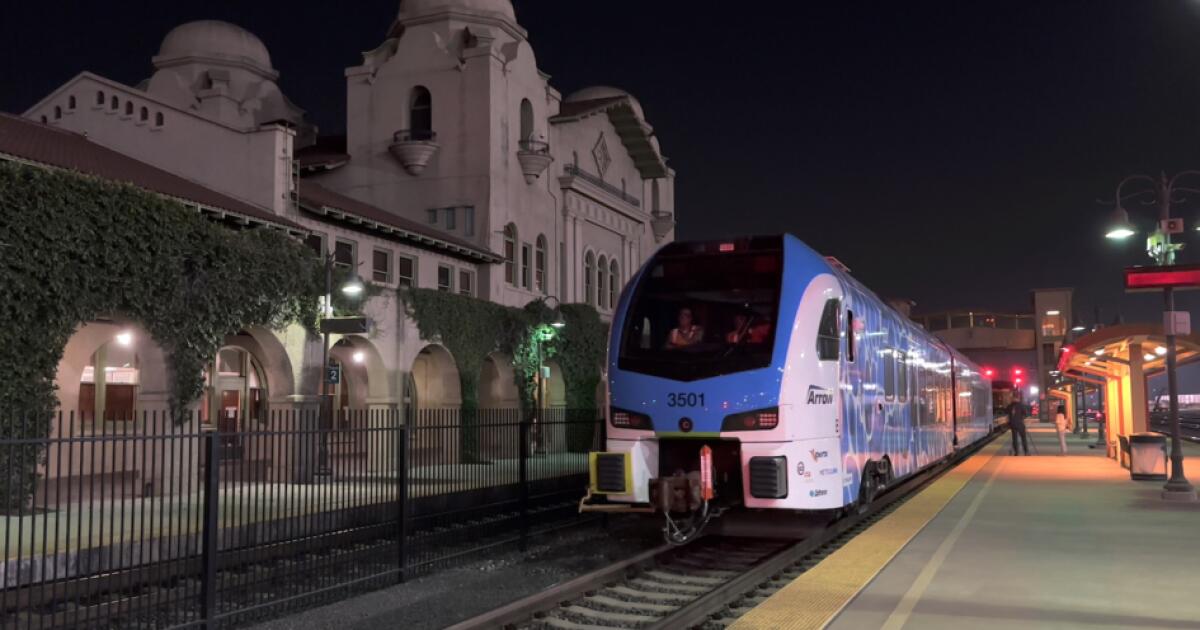The first zero-emission passenger train in the U.S. has rolled into San Bernardino, and passengers should be able to ride the clean-energy line early next year, transportation authorities said.
San Bernardino County Transit Authority presented the $20-million, 108-passenger train — the Zero Emission Multiple Unit, or ZEMU — at a public ceremony Thursday at the San Bernardino Depot Train Station.
ZEMU is North America’s first self-powered, zero-emission passenger train to meet Federal Railroad Administration requirements, according to the transit authority.
“What we have done with ZEMU is transformational,” San Bernardino County Transit Authority President Ray Marquez said in a statement. “The development of the train has solidified SBCTA’s place as an innovator in clean passenger rail here in the Inland Empire, throughout the state and the nation.”
The train will serve the Arrow Line, a 9-mile transit line with five stops between downtown San Bernardino and the University of Redlands.
The zero-emission train represents an environmental transportation coup for the private liberal arts college, which boasts Leadership in Energy and Environmental Design green building standards.
“The Arrow Rail Line has already made a transformative impact on the University of Redlands, linking our students and campus to the greater Southern California region,” University of Redlands President Krista Newkirk said in a statement. “The addition of the first self-powered, zero-emission passenger train takes this progress even further, amplifying our university’s commitment to investing in clean energy.”
ZEMU, a clean-energy train, arrives June 30 in San Bernardino.
(San Bernardino County Transit Authority)
The Arrow Line debuted in October 2022 and allows for westbound connections to Los Angeles’ Union Station.
The Arrow Line is Metrolink’s fastest-growing line, enjoying a 4% weekday increase and a 21% bump in weekend ridership from the previous quarter, according to Metrolink’s third-quarter figures from 2024. The line is the smallest of eight regional routes and serves 416 daily weekday and 6,433 weekend passengers.
ZEMU is expected to be integrated into the Arrow Line’s route shortly after the new year, according to Tim Watkins, SBCTA’s chief legislative and public affairs officer.
The train was built by manufacturer Stadler at its eastern Swiss headquarters before heading to Belgium via truck and barge. It departed on a transatlantic voyage and reached Galveston, Texas, in fall 2023.
It eventually was tested at the Transportation Technology Center in Pueblo, Colo., and then departed Colorado for San Bernardino on June 18, aided by a Burlington Northern Santa Fe locomotive. It pulled into the station on June 21.
ZEMU joins a fleet of three Diesel Multiple Unit trains, built by Stadler, that currently serve the Arrow corridor.
Those DMUs run on renewable fuel made from recycled natural fats and vegetable oils.
ZEMU uses Stadler’s Fast Light Intercity and Regional Train, or FLIRT, concept. The train uses a hybrid hydrogen and battery technology for propulsion and to power onboard electrical systems. Water vapor is the only emission generated from the propulsion system.
Currently, ZEMU is fueled by blue hydrogen, which uses natural gas and a steam reforming process to extract hydrogen. The resulting process produces carbon dioxide that is captured and stored for other uses.
Eventually, the SBCTA hopes to adapt to green hydrogen, a cleaner form of fuel, that relies on electrolysis to extract hydrogen and doesn’t produce a carbon byproduct.
The zero-emission vehicle is a welcome addition to an area that has struggled with breathable air, according to Watkins.
San Bernardino received a letter grade of ”F” or “Fail” in all categories of the 2024 “State of the Air” index by the American Lung Assn. The grades are based on the number of days a county’s air reaches unhealthful levels when measuring ozone and particle pollution.
“We’re in one of the worst air quality attainment areas,” Watkins said. “We’re interested in real solutions that can mitigate those challenges and deliver breathable air.”
SBCTA said it had procured just over $60 million in state and local funding for the project. Other capital uses include testing, research and development and the redevelopment and retrofitting of the Arrow Line’s maintenance facility in San Bernardino to accommodate the larger ZEMU.
The hope, Watkins said, is that this first ZEMU will lead to the conversion of Metrolink’s entire fleet.
